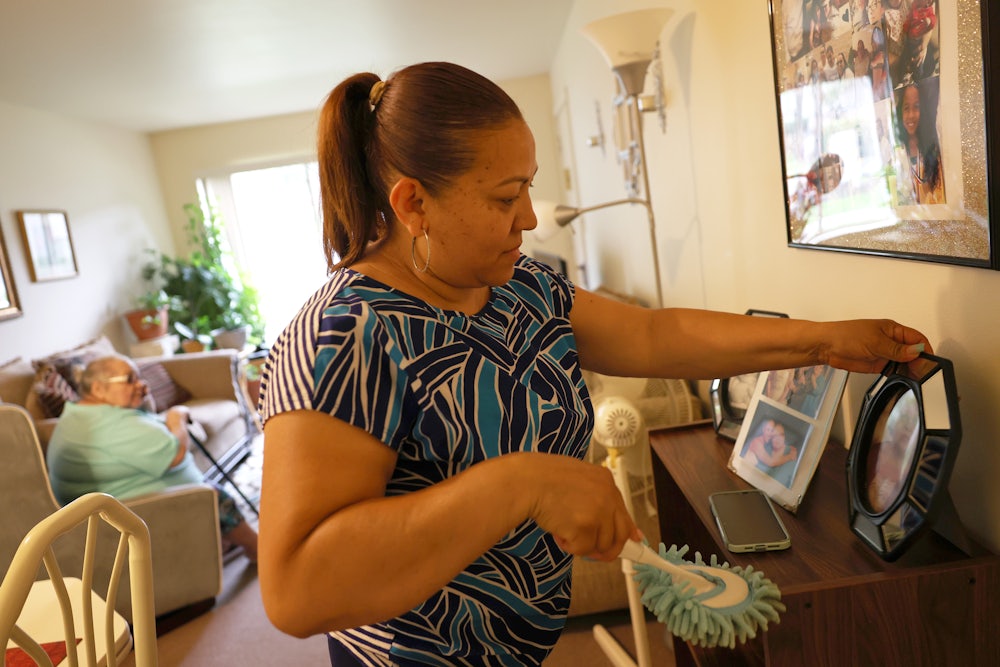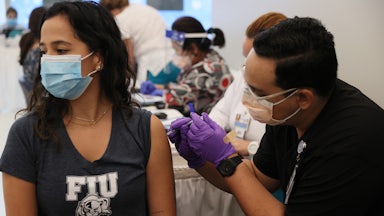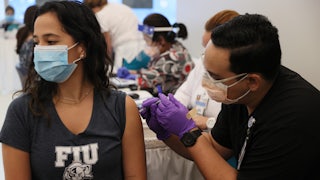Crystal Jackson and her husband live with their three-year-old son in rural Arkansas. Crystal’s husband, Keith, who is 39, was born with cerebral palsy and has had a growing number of health problems in recent years that threaten his independence. Five years ago, an illness put him on dialysis; three years ago, one landed him in the hospital for two weeks. His care needs continue to grow. “It’s a nonstop thing,” Crystal said. “Literally. It is a nonstop thing.”
Crystal helps him manage his medications, keeps him on schedule, and makes sure he schedules and attends the appointments he needs, like dialysis treatment three days a week. Both he and Crystal know there are more challenges waiting in his future—including more potential problems with his kidneys and the prospect of his decreasing mobility—but they haven’t had a discussion yet about how to manage his care so that he can remain safely in their home, or whether to apply for an in-home aide through Medicaid. They both know it’s hard to talk about these things.
Crystal isn’t sure they would want a stranger to come into their home to help. “If it was me doing it, I don’t think he would mind at all,” she said. “But somebody outside the home coming in? I don’t see him actually wanting that.”
What Crystal Jackson describes is the reality for many people who need physical and medical assistance to stay in their homes, whether because of aging or physical disabilities, and their families. Many prefer to have family members provide the help they require with daily tasks, and family members often take on significant caregiving responsibilities, regardless of whatever other assistance they receive. For the family members who provide those duties, 61 percent of whom are women, that work is usually unpaid. As the population of people over 65, who are the primary users of such services, continues to increase, the numbers of women who take on these duties will grow alongside it.
Increasingly, advocates are pushing for those family caregivers to be paid. During the Covid-19 pandemic, about 3.1 percent of home health care professionals, worried about contracting the virus, left the already strained workforce. Many families also wanted limited contact with people outside their homes to avoid exposure to the virus, and so family members took on more caregiving duties. Because of this reality, some state agencies lifted restrictions, through Medicaid waivers, and allowed family caregivers to be paid for the work they do in ways that hadn’t been widespread before. In the American Rescue Plan Act, passed in March, there was a 10 percentage point increase in federal funding for in-home and community-based care services through the Medicaid program, and states are allowed to use some of it to pay family caregivers. States are finalizing their plans now.
Advocates are pushing more states to pay and support family caregivers, both to address the workforce shortage and to honor the work that family caregivers provide. Because the federal government is allowing the temporary funding to be used to pay family caregivers, and because the workforce effects of the pandemic linger, advocates argue this is a unique, urgent moment to act. It’s an opportunity to create new and easier ways for states to lift restrictions that currently prohibit paying some caregivers, and also to make those programs easier to access for families, who themselves might have left the workforce during the pandemic and might be reluctant to return and abandon their caregiving duties. Denise Brown, who founded the Caregiving Years Training Academy, made paying family caregivers her first priority in discussions with states as they finalize plans for the funding. “There’s a change in not only what people are listening to but also what people see as problems,” she said. Before, “there was a very low level of awareness around the family members who provide care.”
Caring for someone with physical or medical needs can be strenuous, sometimes physically dangerous, work, and emotionally taxing. One in-home health aide, recounting the strenuous hours and cut corners enforced by the company where she worked, told The New Republic earlier this year that she struggled with leaving patients after her shift ended. “It just didn’t make me feel right, doing what I did,” she explained. “It was definitely really hard to leave them and say, ‘Your time is up.’” In many states, in-home health care aides are paid minimum wage, or only slightly above, and have few opportunities for advancement. Most can find jobs in other fields for better or equal pay, and they frequently do. Home health care workers were extremely vulnerable to Covid-19 infection, and so many stopped working. In 2020, turnover among the home health aide workforce was 36.5 percent nationwide, even as benefits like hazard pay were instituted. While last year was an unusual one, this was a long-standing problem and will likely continue to be one. In fact, that turnover rate was an improvement over the previous two years: Turnover in the entire home health industry was 64 percent in 2019 and 82 percent in 2018. These jobs are difficult to fill.
Many states plan to use the new funding from Congress to try to enhance the pay for in-home professional aides and create other financial incentives to hire workers and keep them employed. “We need to elevate and celebrate direct support professionals and the key role they play in helping people stay in their homes and continue to be valued members of their communities,” said Natasha Merz, the director of disability services for the Minnesota Department of Human Services. “We need to fundamentally assert and say these roles are not just about getting a paycheck, they are about helping us all as a community have the membership we need and want.”
But another way to address the shortage is to allow more family members to be the primary supports for their loved ones. Almost every state currently allows some payment to family members through the Medicare/Medicaid self-directed care option. In that plan, recipients of care are allowed to act as employers of their own caregivers, with the added duties and freedoms that come with directing their own services. Many hire their own family members. The freedom to direct their own care is critical to making in-home and community-based care the best option for people, Merz says. “I think the lessons we’ve learned are about the most important thing we can do … listen really deeply to what people want in their lives, and then build services and supports to allow that to happen.”
The self-directed option is only used by about 11 percent of care recipients nationwide, according to the Adult Consumer Survey from 2016–2017. In Washington state, one of the states with the highest uptake of these services, about two-thirds of people who receive in-home services choose the self-directed care option, and about 75 to 80 percent of those recipients hire a family member as their caregiver. “Paying family members is a huge part of the solution to the workforce shortage,” says Bea Rector, director of Washington’s Home and Community Based Services. “If somebody can choose a person with whom they already have a giving relationship and trust, they’re much more likely to accept the service. Family members and friends tend to be the best caregivers.”
Washington requires family members to take training courses and provides other supports. The state also pays family caregivers chosen through the self-directed option the same rate that professional aides receive, which ranges between $16 and $19 an hour. That’s close to the state’s minimum wage. “I think this workforce has been invisible for many years,” Rector said. “That is something that has to get corrected. They’re essential workers, they are helping people stay out of institutions.”
There are also protections in place through case management to make sure that the care recipients are receiving the help they need, aren’t subject to abuse and neglect, and have access to outside support when needed.
There are barriers to accessing those services now, as there are with many safety net services around the country: income limits, asset tests, and other requirements. Medicaid or Medicare may pay for these services but try to recoup their costs after that person dies, through what’s called “asset recovery,” if they pass away with an estate valuable enough. For Ken Henderson and his wife, Kristin, who has a physical disability and for whom he provides full-time caregiving support, this has prevented them from seeking payment or help through Medicaid. “We would probably take it up if we didn’t already own the home,” Ken Henderson said. “We want to pass this on for our children.… We just suck it up, and we pay for everything that we need to do around the house.” They’re lucky, he says, because he receives a retirement pension from the military, which means he doesn’t have to work outside of the home.
For families who aren’t in the Hendersons’ position, providing family caregiving services continues to be a strain. More than half work full-time in other jobs and spend a significant amount of time in their caregiving duties, even if they have outside assistance. Burnout and stress are real, for everyone involved. In a 2020 AARP report, only 41 percent of caregivers reported their health as good or very good, a decline from 48 percent five years before, and nearly a quarter said their own health had declined or that they found it difficult to maintain their own health. Programs meant to support family caregivers, like counseling, training, and respite care, also face funding shortages and have waiting lists in many states. Assistance through Medicaid for those who qualify is limited, and private agencies from outside the Medicaid program are expensive. But family caregivers also report that they find their roles rewarding. Reducing other demands on their time and energy while also recognizing and supporting the work they do might lighten those burdens.
Easing some of the requirements and expanding payment programs could help more people who have fewer options than the Hendersons. Crystal Jackson works part-time at a restaurant in her Arkansas town, and her husband collects social security disability and also has very limited hours at the Subway restaurant. But she worries about a time when he won’t be able to work and will need more help from her, and how they’ll make ends meet if she has to stop working. “If he gets sick,” she said, “I’m his sole provider.”








